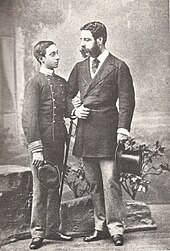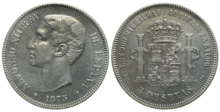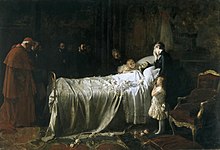Alfonso XII
| Alfonso XII | |||||
|---|---|---|---|---|---|
 Formal portrait, 1875 | |||||
| King of Spain | |||||
| Reign | 29 December 1874 – 25 November 1885 | ||||
| Enthronement | 14 January 1875 | ||||
| Predecessor | Amadeo I(1873) | ||||
| Successor | Alfonso XIII | ||||
| Born | 28 November 1857 Royal Palace of Madrid,Madrid, Spain | ||||
| Died | 25 November 1885(aged 27) Royal Palace of El Pardo,Madrid, Spain | ||||
| Burial | |||||
| Spouses | |||||
| Issue Detail | |||||
| |||||
| House | Bourbon | ||||
| Father | Francisco de Asís, Duke of Cádiz | ||||
| Mother | Isabella II | ||||
| Religion | Catholicism | ||||
| Signature | |||||
Alfonso XII[a](Alfonso Francisco de Asís Fernando Pío Juan María de la Concepción Gregorio Pelayo de Borbón y Borbón; 28 November 1857 – 25 November 1885), also known asEl Pacificador(Spanish:the Peacemaker), wasKing of Spainfrom 29 December 1874 to his death in 1885.
After theGlorious Revolutionof 1868 deposed his motherIsabella IIfrom the throne, Alfonso studied inAustriaand France. His mother abdicated in his favour in 1870, and he returned to Spain as king in 1874 following a military coup against theFirst Spanish Republic.Alfonso died aged 27 in 1885, leaving his pregnant widow,Maria Christina of Austria,as regent of Spain. Their son,Alfonso XIII,became king upon his birth the following year. Maria Christina continued as regent until Alfonso XIII came of age in 1902.
Paternity, early life, and exile
[edit]Alfonso was born inMadridas the eldest son of the reigning QueenIsabella IIon 28 November 1857. His official father, Isabella's husbandFrancisco de Asís,has been generally viewed as effeminate, impotent or homosexual, leading writers to question his biological paternity. There is speculation that Alfonso's biological father may have been Enrique Puigmoltó y Mayans, a captain of the guard.[1]Others have assigned the fatherhood to Federico Puig Romero, acolonelwho was murdered under unclear circumstances in 1866.[2]The relationship of the queen with Puigmoltó was so much of a public hearsay at the time that Francisco de Asís initially refused to attend the baptism ceremony of Alfonso (the heir apparent), though he was eventually forced to do so.[3]
These rumours were used as political propaganda against Alfonso by theCarlists,and he came to be widely nicknamed "Puigmoltejo" in reference to his supposed father.[4][5]His mother's accession had created a second cause of instability, theCarlist Wars,where the supporters ofDon Carlos, Count of Molinaas King of Spain rose to have him enthroned.
In addition, within the context of the post-Napoleonic restorations and revolutions which engulfed Europe and the Americas, both the Carlistas and the Isabelino conservatives were opposed to the new Napoleonic constitutional system. Much like in Britain, which subtracted itself from the liberal constitutional process, Spanish conservatives wanted to continue with the traditional Organic Laws, such as theFuero Juzgo,the Novísima Recopilación and thePartidas of Alfonso X.This led to a third cause of instability, the independence of most of the American possessions, recognized between 1823 and 1850.
When Queen Isabella II and her husband were forced to leave Spain by theRevolution of 1868,Alfonso accompanied them to Paris. From there, he was sent to theTheresianumin Vienna to continue his studies. On 25 June 1870, he was recalled to Paris, where his mother abdicated in his favour, in the presence of a number of Spanish nobles who had tied their fortunes to those of the exiled queen. He assumed the name Alfonso XII, for although no king of united Spain had borne the name "Alfonso", the Spanish monarchy was regarded as continuous with the more ancient monarchy represented by the 11 kings ofAsturias,LeónandCastilealso namedAlfonso.[6]
The Republic
[edit]
After the revolution, theCortesdecided to set up a new dynasty on the throne.Prince Amadeo of Savoy,the younger son of KingVictor Emmanuel II of Italyand a distant cousin of Alfonso by common descent fromCharles III,was recognized as King of Spain in November 1870. During a tumultuous reign, Amadeo was targeted by assassination attempts and struggled with opposition from bothCarlistsandrepublicanswhile his own faction split. After the Carlists revolted and theThird Carlist Warbroke out, heabdicatedand returned to Italy in early 1873.[7]
Following Amadeo's abandonment, theFirst Spanish Republicwas established, including the territories ofCuba,Puerto Ricoand the Pacific Archipelagos. The first act of PresidentEstanislao Figueraswas to extend the abolition of slavery to Puerto Rico; Cuban slaves would have to wait until 1889. The republicans were not in agreement either, and they had to contend with awar in Cubaand Muslim uprisings inSpanish Morocco.In the midst of these crises, the Carlist War continued and the Carlist party made itself strong in areas with claims over their national and institutional specificity such asCataloniaand theBasque Country.This unrest led to the creation of a group in favour of theBourbon Restoration,led by the moderate conservativeAntonio Cánovas del Castillo.
Alfonso was well-educated and cultured, especially compared to his mother. His tutors took great care to have him educated in good schools and to familiarize him with different cultures, languages and government models throughout Europe. During theFranco-Prussian War,Alfonso relocated from Paris toGenevawith his family, and then continued his studies at theTheresianumin Vienna in 1872. Cánovas began to take responsibility for Alfonso's education with the goal of shaping him into the ideal king for the planned Bourbon Restoration, and next sent him to theRoyal Military College, Sandhurst,in England.[8]The training he received there was severe but more cosmopolitan than it would have been in Spain, given its atmosphere at the time.
On 1 December 1874, Alfonso issued theSandhurst Manifesto,where he set the ideological basis of the Bourbon Restoration. It was drafted in reply to a birthday greeting from his followers, a manifesto proclaiming himself the sole representative of the Spanish monarchy. At the end of 1874, BrigadierMartínez Campos,who had long been working more or less openly for the king, led some battalions of the central army toSagunto,rallied the troops sent against him to his own flag, and enteredValenciain the king's name. Thereupon the President resigned, and his power was transferred to the king's plenipotentiary and adviser, Cánovas.[6]With Cánovas disapproval (he detested the intervention of the military in politics),[9]the 29 December 1875pronunciamentoof Gen. Martínez Campos in Sagunto ended the failed republic and meant the rise of the young Prince Alfonso.
Reign
[edit]
Within a few days after Cánovas del Castillo took power as Premier, the new king, proclaimed on 29 December 1874, arrived atMadrid,passing throughBarcelonaandValenciaand was acclaimed everywhere (1875). In 1876, a vigorous campaign against theCarlists,in which the young king took part, resulted in the defeat ofDon Carlosand the Duke's abandonment of the struggle.[6]
Initially led by Cánovas del Castillo as moderate prime minister, what was thought at one time as a coup aimed at placing the military in the political-administrative positions of power, in reality ushered in a civilian regime that lasted untilPrimo de Rivera's 1923 coup d'état. Cánovas was the real architect of the new regime of the Restoration.
In 1881 Alfonso refused to sanction a law by which the ministers were to remain in office for a fixed term of 18 months. Upon the consequent resignation of Cánovas del Castillo, he summonedPráxedes Mateo Sagasta,the Liberal leader, to form a new cabinet.[6]

In order to eliminate one of the problems of the reign ofIsabel II,the single party and its destabilizing consequences, the Liberal Party was allowed to incorporate and participate in national politics, and the 'turnismo' or alternation was to become the new system. Turnismo would be endorsed in theConstitution of 1876and thePact of El Pardo(1885). It meant that liberal and conservative prime ministers would succeed each other ending thus the troubles.
This led to the end of the Carlist revolts and the victory over the New York-backed Cuban revolutionaries, and led to a huge backing both by insular and peninsular Spaniards of Alfonso.[10]

Alfonso's short reign established the foundations for the final socioeconomic recuperation of Spain, bringing an end to the political instability that had dominated Spain for the past two-thirds of a century (seeHistory of Spain (1808–1874)). Both Europe (the coastal regions, such as the Basque Country, Catalonia, and Asturias) and the colonies in the Antilles and Pacific were able to grow steadily. Cuba and Puerto Rico prospered to the point that Spain's first train was not in Spain proper but betweenHavanaandGüinesin Cuba, and the first telegraph in Latin America was in Puerto Rico, established bySamuel Morse,whose daughter and son-in-law lived there. Upon theAmerican invasion of Puerto Rico,ten US dollars were needed to buy one Puerto Rican peso.
Marriages
[edit]On 23 January 1878 at the Basilica ofAtochain Madrid, Alfonso married his first cousin, PrincessMaría de las Mercedes,but she died within six months of the marriage.[6]

On 29 November 1879 at the Basilica of Atocha inMadrid,Alfonso married his double third cousin, ArchduchessMaria Christina of Austria.During the honeymoon, a pastry cook named Otero fired at the young sovereign and his wife as they were driving in Madrid.[6]
The children of this marriage were:
- María de las Mercedes,Princess of Asturias, (11 September 1880 – 17 October 1904), married on 14 February 1901 toPrince Carlos of Bourbon-Two Sicilies.She was titular heir to the throne of Spain from the death of her father until the posthumous birth of her brother.
- María Teresa,(12 November 1882 – 23 September 1912), married toPrince Ferdinand of Bavariaon 12 January 1906
- Alfonso XIII(17 May 1886 – 28 February 1941). Born posthumously. He marriedPrincess Victoria Eugenie of Battenberg
Alfonso had two sons byElena Armanda Nicolasa Sanz y Martínez de Arizala(15 December 1849, inCastellón de la Plana– 24 December 1898, in Paris):
- Alfonso Sanz y Martínez de Arizala (28 January 1880, in Madrid – 19 March 1970, in Paris), married in 1922 to María de Guadalupe de Limantour y Mariscal
- Fernando Sanz y Martínez de Arizala(28 February 1881, in Madrid – 8 January 1925, inPau,France), unmarried and without issue
Death and impact
[edit]
In November 1885, Alfonso died aged 27 at theRoyal Palace of El Pardonear Madrid. He had been suffering fromtuberculosis,but the immediate cause of his death was a recurrence ofdysentery.[11]
In 1902, his widow Maria Cristina initiated a national contest to build amonument in memory of Alfonso.The winning design, byJosé Grases Riera,was constructed in an artificial lake in Madrid'sParque del Buen Retiroin 1922.
Coming to the throne at such an early age Alfonso had served no apprenticeship in the art of ruling. Benevolent and sympathetic in disposition, he won the affection of his people by fearlessly visiting districts ravaged bycholeraor devastated by the1884 Andalusian earthquake.His capacity for dealing with men was considerable, and he never allowed himself to become the instrument of any particular party. During his short reign, peace was established both at home and abroad, finances were well regulated, and the various administrative services were placed on a basis that afterwards enabled Spain to pass through the disastrouswar with the United Stateswithout the threat of a revolution.[6]
Honours
[edit] Spain:Knight of the Golden Fleece,1857[12]
Spain:Knight of the Golden Fleece,1857[12] Kingdom of Portugal:Grand Cross of the Tower and Sword,1861[13]
Kingdom of Portugal:Grand Cross of the Tower and Sword,1861[13] French Empire:Grand Cross of theLegion of Honour,March 1863[14]
French Empire:Grand Cross of theLegion of Honour,March 1863[14] Kingdom of Bavaria:Knight of St. Hubert,1865[15]
Kingdom of Bavaria:Knight of St. Hubert,1865[15] Monaco:Grand Cross of St. Charles,7 September 1865[16]
Monaco:Grand Cross of St. Charles,7 September 1865[16] Belgium:Grand Cordon of theOrder of Leopold(civil),20 February 1866[17]
Belgium:Grand Cordon of theOrder of Leopold(civil),20 February 1866[17] Austria-Hungary:Grand Cross of St. Stephen,1875[18]
Austria-Hungary:Grand Cross of St. Stephen,1875[18] Saxe-Weimar-Eisenach:Grand Cross of the White Falcon,1875[19]
Saxe-Weimar-Eisenach:Grand Cross of the White Falcon,1875[19] Kingdom of Prussia:Knight of the Black Eagle,13 June 1875[20]
Kingdom of Prussia:Knight of the Black Eagle,13 June 1875[20]
 Sweden-Norway:Knight of the Seraphim,23 October 1877[21]
Sweden-Norway:Knight of the Seraphim,23 October 1877[21] Denmark:Knight of the Elephant,8 January 1878[22]
Denmark:Knight of the Elephant,8 January 1878[22] Kingdom of Italy:Knight of the Annunciation,4 February 1878[23]
Kingdom of Italy:Knight of the Annunciation,4 February 1878[23] Empire of Japan:Grand Cordon of theOrder of the Chrysanthemum,11 September 1879[24]
Empire of Japan:Grand Cordon of theOrder of the Chrysanthemum,11 September 1879[24] United Kingdom:Stranger Knight Companion of the Garter,24 October 1881[25]
United Kingdom:Stranger Knight Companion of the Garter,24 October 1881[25] Kingdom of Saxony:Knight of the Rue Crown,1883[26]
Kingdom of Saxony:Knight of the Rue Crown,1883[26]
Ancestry
[edit]See also
[edit]Explanatory notes
[edit]References
[edit]- ^Juan Sisinio Pérez Garzón, Isabel II: Los Espejos de la Reina (2004)
- ^"Maria Nieves Michavila presenta un libro sobre la paternidad del hijo de la reina Isabel II".11 February 2016.
- ^Bermúdez Ruíz-Cabello, María Inmaculada (2013)."Influencias en la imagen pública y privada de una reina: Isabel II (1833–1868)".Aportes.28(83): 129.ISSN0213-5868.
- ^Burgo Tajadura, Jaime Ignacio del(2008).Boletín de la Real Academia de la Historia,p. 242: "A few months later, on the night of November 28 at 10:15, the queen gave birth to a child, who in time would be Alfonso XII, to whom the tongues, more or less deridingly, gave the name of Puigmoltejo".ISSN0034-0626.
- ^"El puñal del godo en la familia Borbón".30 June 2017.
- ^abcdefgOne or more of the preceding sentences incorporates text from a publication now in thepublic domain:Chisholm, Hugh,ed. (1911). "Alphonso s.v. Alphonso XII.".Encyclopædia Britannica.Vol. 1 (11th ed.). Cambridge University Press. p. 736.
- ^"AMEDEO Ferdinando Maria di Savoia, duca di Aosta, re di Spagna".
- ^"Alfonso XII".Real Academia de la Historia.
- ^Carr, Raymond(1980).Modern Spain, 1875-1980.Oxford University Press. p. 3.ISBN9780192158284.OCLC6555498.
- ^Ancede, M. (2020). The Spanish explorer who desecrated graves in the name of science. El Pais.
- ^"Death of the King of Spain",The Times(26 November 1885): 7.
- ^Boettger, T. F."Chevaliers de la Toisón d'Or – Knights of the Golden Fleece".La Confrérie Amicale.Retrieved25 June2019.
- ^"Grand Crosses of the Order of the Tower and Sword".geneall.net.Retrieved 22 September 2018.
- ^M. Wattel, B. Wattel. (2009).Les Grand'Croix de la Légion d'honneur de 1805 à nos jours. Titulaires français et étrangers.Paris: Archives & Culture. p. 448.ISBN978-2-35077-135-9.
- ^Hof- und Staatshandbuch des Königreichs Bayern: 1877.Landesamt. 1877. p. 8.
- ^Journal de Monaco
- ^Almanach royal officiel de Belgique.Librairie polytechnique De Decq. 1867. p. 53.
- ^"A Szent István Rend tagjai"Archived22 December 2010 at theWayback Machine
- ^Staatshandbuch für das Großherzogtum Sachsen / Sachsen-Weimar-EisenachArchived7 October 2019 at theWayback Machine(1885), "Großherzogliche Hausorden" p. 14
- ^"Schwarzer Adler-orden",Königlich Preussische Ordensliste(in German), vol. 1, Berlin, 1877, p.14
{{citation}}:CS1 maint: location missing publisher (link) - ^Sveriges statskalender(in Swedish), 1881, p. 378,archivedfrom the original on 11 June 2011,retrieved6 January2018– via runeberg.org
- ^Jørgen Pedersen (2009).Riddere af Elefantordenen, 1559–2009(in Danish). Syddansk Universitetsforlag. p. 470.ISBN978-87-7674-434-2.
- ^Italia: Ministero dell'interno (1884).Calendario generale del Regno d'Italia.Unione tipografico-editrice. p.48.
- ^Hình bộ phương tắc (2017).Minh trị thời đại の huân chương ngoại giao nghi lễ(PDF)(in Japanese). Minh trị thánh đức ký niệm học hội kỷ yếu. p. 143.Archived(PDF)from the original on 9 October 2022.
- ^Shaw, Wm. A. (1906)The Knights of England,I,London,p. 62
- ^Sachsen (1886–1887). "Königlich Orden".Staatshandbuch für den Königreich Sachsen: 1886/87.Dresden: Heinrich. p.5– via hathitrust.org.
External links
[edit]- Historiaantiqua.Alfonso XII; (Spanish)(2008)
- Alfonso XII
- 1857 births
- 1870s in Spain
- 1880s in Spain
- 1885 deaths
- 19th-century deaths from tuberculosis
- 19th-century Spanish monarchs
- Burials in the Pantheon of Kings at El Escorial
- Captain generals of the Navy
- Collars of the Order of Isabella the Catholic
- Collège Stanislas de Paris alumni
- Crosses of Military Merit
- Crosses of Naval Merit
- Deaths from dysentery
- Extra Knights Companion of the Garter
- Graduates of the Royal Military College, Sandhurst
- Grand Crosses of Military Merit
- Grand Crosses of Naval Merit
- Grand Crosses of the Order of Saint Stephen of Hungary
- Grand Crosses of the Order of Saint-Charles
- Grand Crosses of the Royal and Military Order of San Hermenegild
- Grand Masters of the Order of Alcántara
- Grand Masters of the Order of Calatrava
- Grand Masters of the Order of Isabella the Catholic
- Grand Masters of the Order of Montesa
- Grand Masters of the Order of Santiago
- Grand Masters of the Order of the Golden Fleece
- Grand Masters of the Royal and Military Order of San Hermenegild
- House of Bourbon (Spain)
- Infectious disease deaths in Spain
- Knights Grand Cross of the Order of Isabella the Catholic
- Knights of Calatrava
- Knights of Santiago
- Knights of the Golden Fleece of Spain
- Knights of the Order of Alcántara
- Knights of the Order of Montesa
- Laureate Cross of Saint Ferdinand
- Navarrese titular monarchs
- Nobility from Madrid
- People of the Third Carlist War
- Princes of Asturias
- Recipients of the Royal and Military Order of Saint Hermenegild
- Restoration (Spain)
- Sons of queens regnant
- Spanish captain generals
- Spanish infantes
- Tuberculosis deaths in Spain

